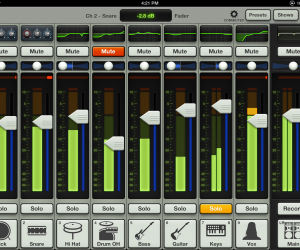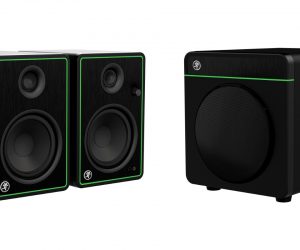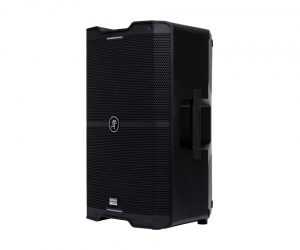
MACKIE HR824mk2
Mackie helped kick off the active nearfield revolution with the hugely popular 824. But is the sequel big news or a re-tread?
Text: Simon Leadley
The advantages of (what I’ll generically call) ‘powered monitors’ are well documented and have been so well received by the marketplace that it’s hard to buy an old-school passive design any more. But, for the record, let’s read from the powered monitor liturgy of what makes them so popular… in a loud, clear voice please:
• There’s no need for racks of high-powered amplifiers.
• There’s no need for lossy and bulky passive crossovers – the electronic ones are far more capable and efficient. Filters can be designed to compensate for positioning (like in the corner of a room were bass is exaggerated).
• Speakers can be matched to the amps and the shorter leads from amps to speaker are a bonus.
• Adding speakers for 5.1 mixing is much, much simpler.
Plus, the most important advantage of powered and active designs is that they generally sound much better than the older conventional systems.
Mackie was one of the first to realise the potential of the nearfield active monitor. The original HR824 was a sales phenomenon, and if ever a monitor could begin to rival the ubiquity of Yamaha’s NS10 then it’s surely the 824. Some 10 years later the 824 is still going strong – you’ll spot them in pro and home studios alike all around the world. So why would Mackie create the mk2? The old adage “If it ain’t broke…” must surely hold true today.
GOT ANY BLACKER?
The first thing that strikes you about the new 824s is the Piano Black finish. They look very impressive, sporting the new, more contemporary rounded shape of many other current designs. All the corners are rounded and smooth, the fascia has no guard or scrim and there’s a moulded waveguide front panel that holds the woofer and tweeter in place. All in all they look far more impressive than the original 824s.
The rear panel meanwhile is similar to the originals, with the power and inputs located near the base. Inserting IEC leads and XLR plugs in this configuration is still an annoying task – they’re often difficult to locate when you’re reaching around from the front – but the advantage is the speakers can be placed right up against a wall without the plugs getting in the way.
The various controls are also on the rear. These include an input sensitivity trim pot calibrated for –10dB in the centre and +4dB at full. This allows each speaker in a multi-speaker system to be calibrated individually if necessary. Then there’s the Quarter/Half/Whole (normal) acoustic space adjustment. This control compensates for bass build-up associated with placing a speaker with its back to the wall or in the corner of a room.
Speaking of bass, the 824mk2s design incorporates a rear-firing passive radiator that contributes significantly to the speaker’s extended bass response. Theoretically, the radiator provides the 824s with the ‘equivalent’ bass response of a 12-inch woofer and, as a result, an excellent low-end response that’s flat to a published 42Hz. Conventional speakers more often than not use either an infinite baffle (closed box) or bass reflex (ported) design to extend the low end, and these designs come with their own set of limitations. The result of Mackie’s approach (the passive radiator is a cone without the voice coil – it moves in sympathy with the push/pull of air in the cab) is a very extended and smooth low end. However, what this theoretically means is that positioning the speaker close to a wall can cause some tricky low-end phase problems. In practice, though, I didn’t experience any difficulties after tweaking the three-position ‘Acoustic Space’ switch.
The low frequency can also be tailored to roll off at 80, 47 and 37Hz (the –3dB point). This can be very useful depending on the room and material you’re working with. If you’re using a bass-managed system it can also be very useful to roll off the bottom end at 80Hz – leaving all the very low-end work to the sub.
BADGE OF HONOUR
The top end is handled by a new one-inch titanium dome tweeter, which performs in conjunction with the aluminium waveguide. You’re also able to tailor the top end by applying some boost or cut (2dB) at 10kHz. As a side note, the tweeter’s position means the mk2s are just as happy on their sides – the Mackie badge even swivels to accommodate this! (Rumour has it that a famous engineer/producer wouldn’t use a particular set of speakers on their sides because “if they were designed to be used on their sides, the badge would turn” – well these do!) Speaking of mounting, the Mackies have an ‘omni mount’ to allow the speakers to be fixed to walls or ceilings. Thanks to this feature and the Acoustic Space switching you’ve now got no excuse for not finding spots for all five speakers in a multi-channel setup.
Rounding out the rear panel, there are three types of analogue connection to the speakers: <<1/4>>-inch, XLR and RCA, so there’s no need to have a pocket full of adaptors if you carry the speakers around with you! This is a great feature. It’s also interesting to note that Mackie doesn’t include a digital input like many of the other new-generation speakers. Personally, I like to be able to choose my converters, and leave the speakers to do what they do best rather than worrying about another D/A converter that could impact on the overall sound.
POWER
The speakers are driven by two dual Class A/B amplifiers with overload protection. The bottom end is driven by a 150W amp, and the tweeter a generous 100W. I was very surprised to make this discovery, actually, as most speakers these days are driven by the newer, lighter and (I’m guessing, cheaper) Class D amplifiers.
The mk2s also have an ‘auto power’ mode that switches the speakers into standby mode if no signal is detected. They then turn back on when the signal exceeds –45dB; the front panel power switch and LED surround indicating the status of the speakers. Mercifully, this power indicator isn’t a piercingly bright blue laser beam as seems fashionable as the moment. Put simply, the Mackies don’t force you to place a piece of gaff over the power indicators!
TESTING TIMES
On first listen Mackie HR824mk2s sounded a lot like the old 824s, albeit with a smoother top end. The bottom end was extended and much the same as the older speakers. There was, however, a lump in the lower midrange that concerned me at first, until I explored all the settings on the speaker. I rolled off the bottom end and set it to ‘Half Space’ (as they were placed near the front wall in the mix room). Our new studio at Trackdown is setup of bass management, so I tried rolling off the bottom end (both with the in-built filter and the management of the desk). This worked well and the sound was very clean and undistorted even at high levels.
The original 824s were known for their inoffensive sound – they were non-fatiguing and easy to listen to over long periods of time. The knock-on benefit of this is that the original 824s translate very, very well over a wide range of other speakers – in my experience, if a mix sounds good on the 824s then it sounds good in most situations. I have colleagues in recording and post production who have used the original Mackies for years and are more than happy with the results. They’ve always mentioned that they find the speakers very non-fatiguing and easy to listen to. Unlike some speakers they don’t tend to ‘bark’ at you.
A BRIGHTER FUTURE
In the time I had the speakers I found them very similar to the originals but with a brighter sound and more distinct image. Mono’ing a sound made it very defined in the phantom centre – there was no feeling that the speakers crossed over at any point. A noise sweep was smooth and even across the frequency range with no obvious dips or peaks. I mixed a few tracks and was very pleased with the results. A/B’ing the mixes on other speakers revealed a well balanced tone – I did the mandatory ‘mp3 in the car’ test as well as listening at home on my B&W bookshelf speakers, and the ‘824mk2 mixes’ translated very well in both these environments.
If you’re looking for a good value, accurate, easy to listen to, yet powerful set of nearfields, the Mackie HR824mk2s are excellent candidates. They maintain the same footprint of the original speakers and share much of the overall sound as the mk1s, but the top end is improved. The waveguides clarify the imaging and the results are a smoother and more accurate speaker all round.
My only concern would be the rear facing passive driver (which potentially limits the placement of the speakers near walls) and the inaccessibility of the inputs (admittedly there’s a logical reason for this, but it’s still difficult to connect cables without a torch).
As each speaker is individually tuned and measured it’s easy to be confident that you’re buying a genuinely matched and reasonably priced 5.1 setup (though the smaller and cheaper 624s would also be a great choice for the surround speakers). These speakers represent excellent value for the performance they deliver.
MAKING THEIR MK2
Speakers are always a matter for personal taste but for me the HR824mk2s are a very good all-round speaker that can confidently replay all types of music from rock to classical – well worth checking out. Plus, THX approval means that they’ve had to pass a rigorous specification test that makes them ideal for mixing for TV and Film.

















RESPONSES